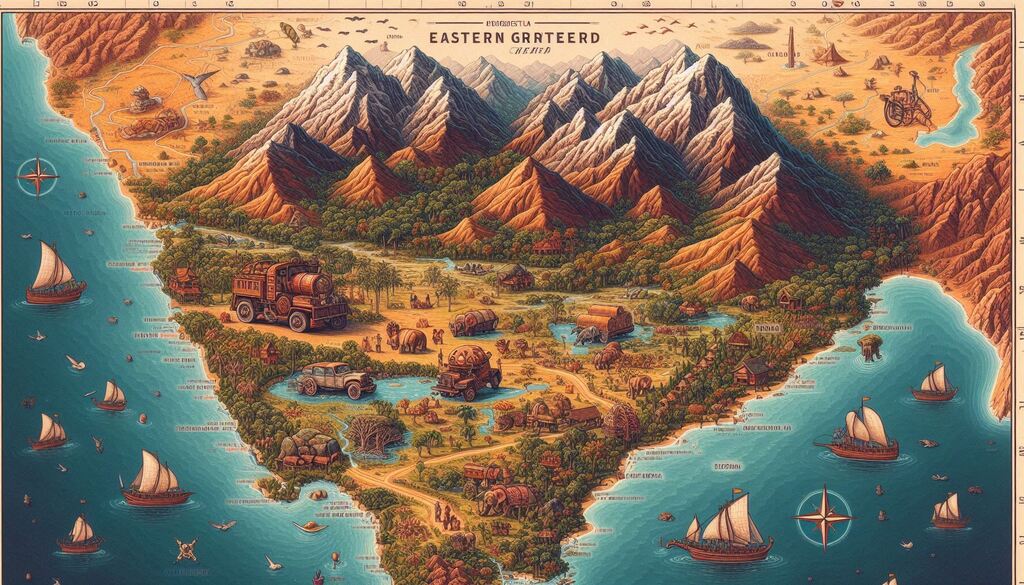
Introduction
The Eastern ghats in India Map comprise a major east–west mountain range in India, which contain various ecosystems and spans over a large number of states. The Eastern ghats in India Map are a discontinuous range of mountains that stretch from West Bengal in the north, running progressively south and up to Tamil Nadu; towards its southernmost point it ends with Cape Comorin (Kanyakumari). This article examines the geographical uniqueness, ecological diversity, cultural richness and conservation concerns attached to Eastern Ghats along with mapping of Eastern ghats.
Geographical Significance
It stretches from West Bengal in the north, passes through Odisha and Andhra Pradesh states to Tamil Nadu on South. Nallamala Hills, Velikonda Range, Pachaimalai hills and the Javadi Hills are all associated with this range. The heights of the Eastern ghats in india Map range between 150 metres and 1,080 metres above its eastern flank whereas on the western side it falls….Processed with VSCO Reg A6 Preset The highest peak in the Eastern ghats in india Map is Arma Konda (or Jindhagada) at 1,680 metres.
They are parallel to the Bay of Bengal but unlike other ranges, do not seem to be continuous and are lower when compared with western ghats. The region acts as a barrier to the monsoon winds, and plays an important role in influencing the climate of eastern coastal plains with significant rainfall distribution over viswa whereas western ghats receive heavy rain amounts causing losses on agriculture sources.
Ecological Diversity
Eastern ghats map in India are a bio-hotspot is home to diverse ecosystems and rich wealth of flora and fauna. Its vast expanse of geomorphology too has contributed to the astounding assortment of Biomes in India, ranging from Teak-rich Monsoonal Tropical moist deciduous and dry thorn forests (10% world flora in only 1 State alone) right up till nevervisions grade lang also.INTERNAL CHINA_TOWN Pr-Industrial Age Amazon Rainforest. As the highest and driest desert on Earth, this area is a centre of endemic plant endemism as well as one of the most biologically diverse regions in 20 % from succulents within an area anywhere.
In contrast to western ghats,Eastern ghats in India Map houses some major fauna particularly Bengal tiger, Indian elephant and leopard along with many other species such asIndian pangolin. Some of the amphibians, reptiles and birds are found nowhere else in the cordillera as well. Map of the Eastern ghatas in India The Western ghats are especially rich, and many endemic species may be found there; among them is Jerdon’s courser (Rhynchotus jerdoni), an endangered bird that only one other nocturnal birds can inhabit this treasure chest.
Various medicinal plants including red sanders also known as the vermillion-coloured, and many economically important plant species considered to be endangered with industrial exploitation such as teak, neem etc. are found in these ranges.once again CSS namespace The disparate ecosystems in the area cater for a wide variety of ecosystem services crucial areas such as water regulation, soil conservation and carbon sequestration hence it is an important region to target with our KBA programme.
Cultural and historic significance
Apart from being important in terms of natural beauty and ecological value, Eastern Ghats are equally significant culturally as well historically. For centuries now, the very hills and valleys of the Eastern ghats in india Map have been inhabited by various indigenous communities. They are deeply tied to the land — their forests and rivers, which sustain traditionally forest-dependent communities with customs, languages and living patterns that derive from nature.
The Eastern ghats in India Map are dense with temples and pilgrimage sites, perceived as evidence of the rich cultural history. For example, few hills in the Eastern Ghats include Tirupati (located in Andhra Pradesh) and this area is famous for Venkateswara Temple hill which is among one of the most visited religious sites all over the world. Further, the Araku Valley in Andhra Pradesh is visited by tourists and researchers for its Coffee Plantations & Tribal Culture.
Representation on the Map
The Eastern ghats in india Map need to be mapped if we ever hope to understand how extensive they are, what ecological zone has survived and where humans have settled. Almost represented by a series of cracked hill ranges, the Eastern Ghats are mapped between the northern periphery of Odisha and closing in at Cape Comorin on Tamil Nadu. The maps underscore how broken the range is, due to wide valleys where mountains become plain or shallow ridges that are lower and less well-defined.
Detailed maps of the Eastern Ghats would also show a map of some major rivers starting from this range into the plains – Godavari, Krishna, Pennar- which not only nurture agriculture in these regions but feed millions with livelihoods. All the maps give information on major wildlife sanctuaries and national parks in Eastern Ghats like Simlipal National Park, Odisha; Papikonda National PArk, Andhra Pradesh and Sathyamangalam Wildlife SanctuaryTamil Nadu.
These detailed topographic maps of the Eastern Ghats are invaluable to researchers and conservationists, as they contain information on terrain, elevation and forest cover which is essential when planning conservation strategies or understanding ecological dynamics of this region.
Conservation Challenges
However, the Eastern ghats in india Map is an ecological hotspot just like its western cousin with high levels of endemism and much cultural significance, it also faces conservation challenges. Degradation of the rainforest is caused by deforestation, mining, agriculture and urbanisation which result in habitat fragmentation thus loss of biodiversity. There are fewer designated protected areas in the region and therefore, greater threats to the endemic diversity of Eastern ghats compared to Western Ghats.
Forests in the Eastern Ghats are facing a big threat because of illegal logging especially of valuable red sanders species. ~Illegal Red Sanders Logging In The Heart Of Andhra Pradesh, India~ Constructing dams and infrastructure projects further distorted the river’s flow leading to a huge impact on ecology. Besides local development impacts, the Eastern Ghats are also threatened by climate change in the long term: changes to temperature and rainfall patterns will affect ecosystem balances that have taken millions of years to establish.
New conservation programmes in Eastern ghats in india Map should be initiated by providing them more protection without considering the damaged habitat and also include various strategies to take local communities into confidence. Unless there is a paradigm shift in development practices that can balance economic growth with ecological well-being, the Eastern Ghats will become another coffin.
Conclusion
India: The Eastern ghats in india Map, a land of rich ecological significance, cultural heritage and geographical importance The Eastern ghats in india Map are not only home to a treasure of naturally-occurring biodiversity and diverse ecosystems, but they also have rich cultural heritage apart from playing a crucial role in the region’s climate. And yet, they are also a region in peril as there is an array of growing problems that need to be addressed and resolved posthaste.
This type of mapping of the Eastern ghats in India Map is significant as it aims to reveal how complex this geography has shaped its evolution and drives conservation strategies. By promoting awareness on the importance of Eastern Ghats, and acting towards conserving this one-of-a-kind heritage, can make our future generations see an alive/living Eastern Ghats.





